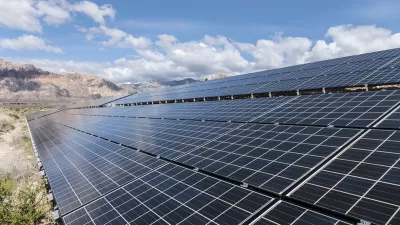The sixth-largest self-storage company in the United States will add solar panels to 8.5 million square feet of its facilities’ rooftops to produce community solar power.

Self-storage powerhouse National Storage Affiliates Trust, in partnership with community solar developer Solar Landscape, is set to add solar panels to 8.5 million square feet of its rooftop space, according to an article from Electrek. “That’s enough solar panels to cover roughly 1,000 of NSA’s self-storage properties scattered across 42 states and Puerto Rico,” and is equal to 100 megawatts of solar capacity to power not just NSA facilities but also nearby homes and businesses. And thanks to the community solar model, the energy will be discounted, reports Michelle Lewis. “This setup means energy gets produced right where it’s needed, reducing strain on the grid and cutting down on energy costs for locals.”
As part of the partnership, NSA will lease Solar Landscape its rooftop space, while Solar Landscape will develop, own, and operate the solar systems. According to the article, the first sites are already under development. In another Electrek article from last year, Lewis reported that industrial rooftops are prime candidates for solar panel space; the U.S. has more than 450,000 warehouses and distribution centers offering up more than 16.4 billion of roof area. “[T]he rooftops of US warehouses built before 2019 alone have the potential to generate 185.6 terawatt-hours (TWh) of solar electricity annually – enough to power 19.4 million average households. That’s equivalent to roughly the entire New York-Newark-Jersey City metropolitan area,” according to the 2023 article.
Given concerns about solar farms taking valuable farmland out of production, turning to large-footprint industrial rooftops to host panels could certainly be a promising alternative.
FULL STORY: 8.5M square feet of US self-storage rooftops are getting solar

Alabama: Trump Terminates Settlements for Black Communities Harmed By Raw Sewage
Trump deemed the landmark civil rights agreement “illegal DEI and environmental justice policy.”

Planetizen Federal Action Tracker
A weekly monitor of how Trump’s orders and actions are impacting planners and planning in America.

The 120 Year Old Tiny Home Villages That Sheltered San Francisco’s Earthquake Refugees
More than a century ago, San Francisco mobilized to house thousands of residents displaced by the 1906 earthquake. Could their strategy offer a model for the present?

BLM To Rescind Public Lands Rule
The change will downgrade conservation, once again putting federal land at risk for mining and other extractive uses.

Indy Neighborhood Group Builds Temporary Multi-Use Path
Community members, aided in part by funding from the city, repurposed a vehicle lane to create a protected bike and pedestrian path for the summer season.

Congestion Pricing Drops Holland Tunnel Delays by 65 Percent
New York City’s contentious tolling program has yielded improved traffic and roughly $100 million in revenue for the MTA.
Urban Design for Planners 1: Software Tools
This six-course series explores essential urban design concepts using open source software and equips planners with the tools they need to participate fully in the urban design process.
Planning for Universal Design
Learn the tools for implementing Universal Design in planning regulations.
Clanton & Associates, Inc.
Jessamine County Fiscal Court
Institute for Housing and Urban Development Studies (IHS)
City of Grandview
Harvard GSD Executive Education
Toledo-Lucas County Plan Commissions
Salt Lake City
NYU Wagner Graduate School of Public Service





























